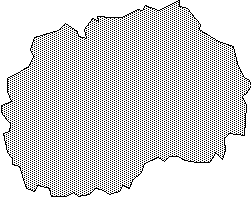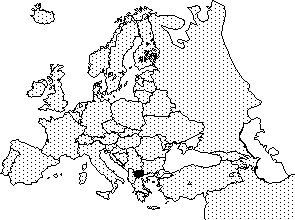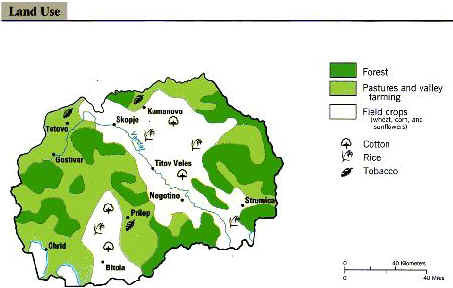[Front page] [Contents] [Previous] [Next] |
Management of Contaminated Sites and Land in Central and Eastern Europe
F.Y.R of Macedonia
Country Characterisation


Background
In the F.Y. Republic of Macedonia, contaminated land is only partially detected and, therefore, there is a lack of research on this topic.
The legislation concerning contaminated land is in a preparatory phase, and hopefully will be adopted by the end of 1999.
General land use in the F.Y. Republic of Macedonia is illustrated on the map below.

Total area |
Agricultural areas |
Wooded areas |
Pastures |
Barren land |
Lakes |
Urban areas |
||||||
km2 |
km2 | % | km2 | % | km2 | % | km2 | % | km2 | % | km2 | % |
25713 |
6428 | 25 | 9514 | 37 | 6428 | 25 | 2057 | 8 | 514 | 2 | 514 | 2 |
| Figure on total area from UN/ECE, 1998. | ||||||||||||
Population |
Population density |
Annual pop. growth |
Life expectancy at birth Male Female |
|||||||||
1000 |
per km2 |
% |
years |
years |
||||||||
| 1983 | 77 | 1,11 | 70 | 74 | ||||||||
| Figures from UN/ECE, 1998, and POPIN, 1999. | ||||||||||||
Legal and Administrative Basis
Definition of Contaminated Sites and Land
As contaminated sites and land are regarded those areas in which one or more harmful matters exceed MPC (maximum permissible concentrations), as scientifically identified and legally accepted.
Legislation
As far as the legislation on land contaminated with harmful matters is concerned, in the Republic of Macedonia, there is no individual definition of MPC for harmful matters by means of legal act. The science uses international information available on MPC, which are not harmonised at the level of Europe and wider.
Implementation of Limit Values
The implementation of limit values for land contaminated with harmful matters in the Republic of Macedonia, for inspection and control purposes, is not carried out, for reasons mentioned under the above item. On the basis of scientific research projects and works, conducted for scientific purposes, we have achieved original results with reference to certain contaminated sites and contaminants, and we compare our results with international scientific results.
Responsible Public Authorities
Responsible public authorities for the subject matter are the competent Ministries that deal with issues of this kind (Ministry of Agriculture, Forestry and Water Economy, Ministry of Environment, and Scientific Institutions: Faculty of Agriculture and relevant Institutes).
Registration
According to our knowledge, registration of the listed institutions, responsible for the subject matter, is not carried out yet.
Characterisation of Soil and Groundwater Contamination
Sources of Soil and Groundwater Contamination
The soil and ground waters can be disposed to contamination by harmful matters from various sources, most significant among which in Macedonia are the following:
- Agrochemicals (mineral fertilisers and pesticides) if used uncontrolled.
- Untreated industrial wastewater from dirty industry, used for irrigation of agricultural crops.
- Unprotected mining facilities, especially disposal sites with hazardous toxic material and industrial waste disposal sites.
- Live stock breeding farms lacking developed supplementary facilities (solid waste storage and wastewater collecting facilities).
- Thermal power plants using coal or similar type of fuel.
- Air pollution from industry and erosion from waste disposal sites.
Number of Registered Contaminated Sites / Contaminated Land Areas
According to the scientific researches conducted in the Republic of Macedonia so far, which have not covered the whole territory of the country, the number of contaminated sites is between 4 and 6. Theoretically we assume that there are about 10 such sites.
Investigation Methods
Identification of Potentially Contaminated Sites and Areas
According to the scientific researches conducted in the Republic of Macedonia so far, there are contaminated sites in the following areas: Veles, Kriva Palanka, Probistip, as well as along the flow of some rivers: Bregalnica, Zletovska, Kumanovska, Vardar at certain sites, live stock breeding farms.
Investigation of Contaminated Sites and Areas
At the above-mentioned sites, some harmful matters have been investigated, including mainly heavy metals and certain organic pollutants. Investigation methods are based on the modern world investigations, for the purpose of which appropriate methodology is used, such as: atomic adsorption spectophotometry and chromatography.
Facilities for Contaminated Soil
Handling and Treatment of Excavated Contaminated Soil
There are no treatment measures undertaken with regard to contaminated soils for various reasons, the most significant being financial constraints and undefined range of the total contaminated area, due to the lack of relevant studies.
Measures Used by Remediation of Soil and Groundwater Contamination
So far, there have been no organised applied measures aimed at remediation of soil and groundwater at the level of entire site. Probation recultivation on small parcels were carried out, by investigation through grass seeding and sols rinsing from the soil with fresh water, and several other small investigations.
Financing and Liability
Investigation and Remediation Activities
In the course of the last 20 to 30 years, 12 to 15 researches have been working on scientific, scientific and professional and professional researches regarding soil contamination with harmful matters in the Republic of Macedonia. The majority of those researches have been published in magazines and collections. There have been a small number of remediation activities (2-3).
Legal Requirements re. Polluters and Site Owners
In my knowledge, there has been one court dispute for soil contamination in the vicinity of Kriva Palanka, where several site owners requested legal protection against contamination of the soil caused by the disposal site of the Toranica mine as polluter. The dispute won the applicants requesting compensation for the suffered damage.
Scope of the Problem
Scale of the Problem and Handling Costs
The scale of the problem connected with the soil contamination should be identified for all sites. For that purpose, the Faculty of Agriculture in Skopje, Division for Agrochemistry has developed a proposal project for investigation, including ten sites in the Republic of Macedonia. The Project is titled "Agrochemical, Physiological and Health Aspects of the Soil, Irrigation Water and Plant Products Contamination with Harmful Matters and Measures for Production of Health Safe Food". The implementing institution of this Project is the Faculty of Agriculture - Skopje, while participants are the Republican Institute for Health Protection and Faculty of Science and Mathematics. This project was positively assessed by the reviewers from the Ministry of Science, but because of the improper approved financial resources; the project is not implemented yet.
Priority in Relation to Other Societal Problems
The above mentioned proposal project should be given top priority, because there has already been a case of displacement of a population from one site as a result of long lasting soil contamination. It is the case of the site in the vicinity of Kriva Palanka.
Illustrative Cases
A typical case is mentioned under the paragraph "Priority in Relation to Other Societal Problems". Similar cases can occur in other areas, such as Veles, Probistip etc.
References
Information provided by Kiril Kalkasliev and Ljupco Avramovski at the Fund for Environment and Nature Protection and Promotion in the Ministry of Environment of the F.Y. Republic of Macedonia. May 5, 1999.
Jekic, M. & Dzekova Marija (1985). Agrochemistry I and II volume. "Kiril and Metodij" University, Faculty of Agriculture - Skopje.
Mitriceski, J. & Mitkova Tatjana (1994). Contents of Heavy Metals in Rice Soils in the Fields of Kocani. XIX Consultation on Plants Protection, Ohrid.
Mulev, M., Melovski, Lj. & Deralieva Lidija (1993). Contents of Some Heavy Metals in the Soil and Leafs and Fir Bark (Abies sp.) in the City of Skopje. Ecology and Environment Protection. Volume I, No. 1-2, 52-62, Skopje.
Petkovski, D. (1995). Contents of Some Non-Volatile Heavy Metals (Mn, Fe, Cu, Zn, Co and Pb) in Ovce Pole. Ecology and Environment Protection. No. 1-2, Skopje.
Trpeski, V. (1995). Impact from Biogenic and Heavy Elements in the Soil and Quality of Plant Products. Environment, No. 1 1995, 31-34, Skopje.
Trpeski, V. (1996). Some Aspects of NEAP on Agricultural Areas Management and Environment Protection. Environment, No. 1, 43-45, Skopje.
Hristovski, V. (1980). Impacts of the Contamination of Bregalnica River Waters by Heavy Metals on Rice Fields and Rice and Possibilities for their Removal. Master Work, manuscript. Technological Faculty, Skopje.
Dzekova, Marija, Trpeski, V., Tanevski B. & Spasovski K. (1988). Contents of Lead and Zinc in the Soil and Certain Agricultural Crops Depending on the Distance from Pollution Sources. Final Report, manuscript. Faculty of Agriculture, OOZT Institute for Soils Investigation, Skopje.
Trpeski, V., S. Prendzov & Marina Stojanova (1988). Contents of Lead and Zinc in the Soil in the Area around the Mine of Toranica, in the Vicinity of Kriva Palanka. Collection of Works, Faculty of Economy, Skopje.
Trpeski, Vidoja, Angelina Stojkovska, J. Spirovski & S. Prendzov (1998). Agro-Ecological Aspects of Grass Seeding in Apple Fruit Yards. I Congress of Ecologists of Macedonia with International Participation, 20-24 September 1998, Ohrid, Republic of Macedonia.
Trpeski, Vidoja, Marija Dzekova, K. Spasovski & T. Avramovski (1998). Lead and Zinc in the Soil and Certain Agricultural Crops Near the Source of Contamination "Zletovo" Smelters Veles. I Congress of Ecologists of Macedonia with International Participation, 20-24 September 1998, Ohrid, Republic of Macedonia.
POPIN (Population Information Network) (1999). The Demography of Countries with Economies in Transition. At gopher://gopher.undp.org/00/ungophers/popin/wdtrends.
UN/ECE Statistical Division (1998). Trends in Europe and North America. 1998 Statistical Yearbook of the UN/ECE. At http://www.unece.org/stats/trend/trend_h.htm. Based on figures from 1994 – 1997.
[Front page] [Contents] [Previous] [Next] [Top] |